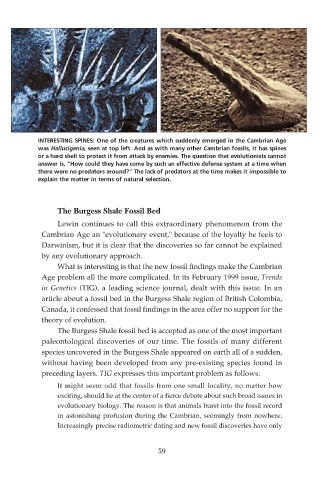Page 61 - Darwinism Refuted
P. 61
INTERESTING SPINES: One of the creatures which suddenly emerged in the Cambrian Age
was Hallucigenia, seen at top left. And as with many other Cambrian fossils, it has spines
or a hard shell to protect it from attack by enemies. The question that evolutionists cannot
answer is, "How could they have come by such an effective defense system at a time when
there were no predators around?" The lack of predators at the time makes it impossible to
explain the matter in terms of natural selection.
The Burgess Shale Fossil Bed
Lewin continues to call this extraordinary phenomenon from the
Cambrian Age an "evolutionary event," because of the loyalty he feels to
Darwinism, but it is clear that the discoveries so far cannot be explained
by any evolutionary approach.
What is interesting is that the new fossil findings make the Cambrian
Age problem all the more complicated. In its February 1999 issue, Trends
in Genetics (TIG), a leading science journal, dealt with this issue. In an
article about a fossil bed in the Burgess Shale region of British Colombia,
Canada, it confessed that fossil findings in the area offer no support for the
theory of evolution.
The Burgess Shale fossil bed is accepted as one of the most important
paleontological discoveries of our time. The fossils of many different
species uncovered in the Burgess Shale appeared on earth all of a sudden,
without having been developed from any pre-existing species found in
preceding layers. TIG expresses this important problem as follows:
It might seem odd that fossils from one small locality, no matter how
exciting, should lie at the center of a fierce debate about such broad issues in
evolutionary biology. The reason is that animals burst into the fossil record
in astonishing profusion during the Cambrian, seemingly from nowhere.
Increasingly precise radiometric dating and new fossil discoveries have only
59

